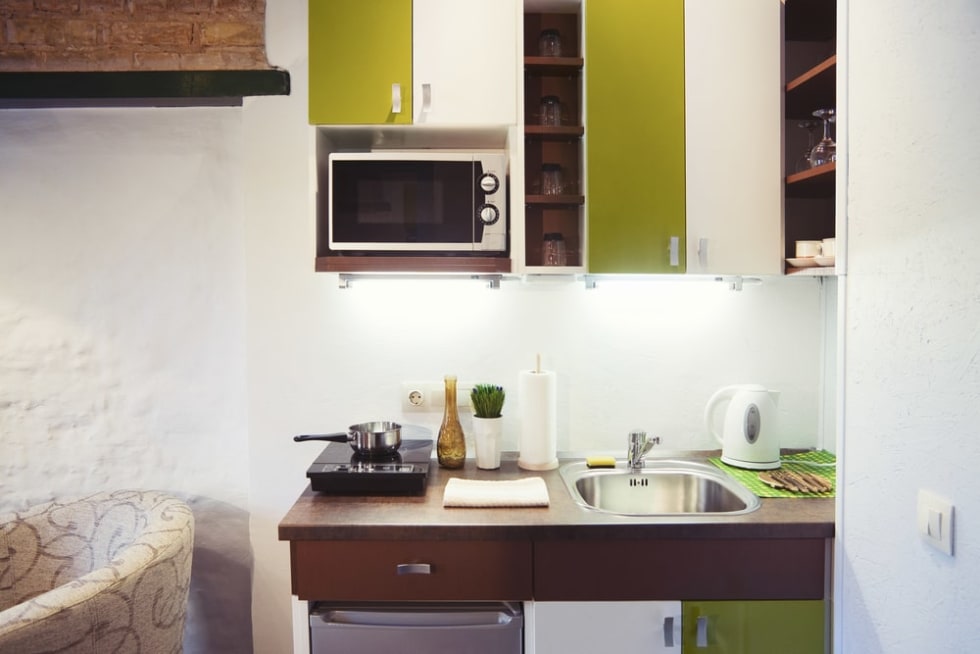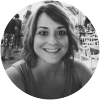Micro-Units and Micro-Apartments: What Are They?

Forget studio apartments. Micro-apartments are the trend-setting standard for tiny dwellings in city centers.
These small apartments embody the spirit of tiny home living, only in an urban atmosphere with all of the amenities you could hope for.
But is a micro-apartment right for you? Below is everything you need to know before you downsize your way to cozy city living.
Micro-Apartments
What is a Micro-Apartment?
Micro-apartments (AKA micro-units) are smaller-than-average studio apartments (i.e. one-room apartments) with a footprint typically between 200 and 400 square feet. Micro-apartments are NOT small one-bedrooms. They’re usually a studio-style, open concept area where a bedroom, living space, and kitchen blend together.
You can also think of a micro-apartment as an efficiency apartment with small amenities complete with a lofted bed to free up precious space. However, micro-unit renters usually enjoy more upscale amenities and convenient locations for smaller price tags.
Despite the small size, micro-units are designed for maximum efficiency. They often have high ceilings and oversized windows to make them feel larger than they really are. Pick the right city and location, and your small apartment may feature dazzling city views.

Why Do People Live in Micro-Apartments?
Because micro-apartments are typically smaller than traditional apartments, that translates to significantly lower rent. This affordability makes it possible to live in trendy, central locations that might otherwise be out of reach. You can be right in the heart of the action, close to work, entertainment, and dining, without breaking the bank.
Furthermore, many micro-apartments often pack a big punch when it comes to functionality and features. While the square footage may be compact, some micro-apartments boast sleek, space-saving furniture and built-in storage solutions that maximize every inch. Additionally, some micro-apartment buildings compensate for the smaller living quarters by offering high-end amenities you might not find in a traditional apartment, like rooftop terraces, fitness centers, and co-working spaces.
Finally, some people prefer micro-apartment living because of the minimalist lifestyle. With less space, you're naturally less likely to accumulate clutter. This can be freeing for those who appreciate a streamlined aesthetic and easier upkeep. Less space also means less cleaning – a big plus for busy urban dwellers.
What Are the Disadvantage of Micro-Apartments?
The obvious disadvantage of the micro-unit is limited space, which can translate into a few issues:
Limited Space: This might seem obvious, but it's worth emphasizing. Micro-apartments by definition have very little square footage. This can feel cramped and claustrophobic, especially for those accustomed to larger living spaces. Activities like entertaining guests, working from home, or having hobbies that require space can be challenging in a micro-apartment.
- Storage Woes: With limited square footage comes limited storage. Unless the micro-apartment boasts well-designed built-in storage solutions, you might find yourself struggling to find places for your belongings. This can lead to clutter and a sense of disorganization.
- Not Ideal for Couples or Families: Micro-apartments are really designed for single occupants or, at most, couples who are minimalists and comfortable with very close quarters. Having children or even large pets can be impractical in such a small space.
- Lack of Privacy: Thin walls and close proximity to neighbors can be an issue in some micro-apartment buildings. This can be disruptive if you value peace and quiet, or if you have noisy neighbors.
Who Lives in Micro-Apartments?
Micro-apartments can house a wide variety of ages and demographics. However, they are targeted towards single twenty-somethings and millennials with city jobs.
Their income levels are often higher than most. Also, people in that demographic are looking for everything urban living has to offer, from pubs and restaurants to museums and parks.
Micro-living is all about lifestyle and convenience. It simply isn’t ideal for everyone. These cozy apartments usually aren’t right for families or anyone struggling to make ends meet.
And due to their small size, micro-apartments aren’t suitable for roommates and long-term visitors who want to crash on your couch indefinitely.

What is it Like Living in a Micro-Apartment?
You'll likely start your day by waking up in your Murphy bed. You'll handle your morning routine but will probably need to make and store your bed until you need it again at the end of the day. If you work from home, you'll need a dedicated work desk set up, likely a few feet away from your bed, or you'll move to a shared workspace either in your apartment complex or nearby.
If you're heading out to work, you can grab a meal in your kitchen, which will also be a few feet from your desk, bathroom, and bedroom.
Just keep in mind, when you get home at night, the reduced size means you'll have to get a lot done within a small space. Consider solutions like TV projectors, convertible tables, and Unless an activity requires the entire space within an empty room to perform, you'll be able to do it in a small area.
Where are Micro-Apartments Popular?
Micro-apartments are popular in densely populated cities and common in large European and Asian cities.
Micro-apartments have begun to spring up in cities like New York, Seattle, and Boston in recent years. However, micro-apartments are still far from common in the US.
Amenities to Look For in Micro-Units
Finding the right amenities and features are key when choosing a micro-apartment. Without the right layout and space-saving features, micro-apartment units can feel positively cramped.
1. Illusion of Space
Look for features that create the illusion of space. Those can include high ceilings, balconies, or decks. They may also feature storage solutions like vertical cabinets to keep your micro-apartment feeling as spacious as possible.
2. Common Areas
An upscale micro-apartment building also features common spaces like spacious lobbies and rooftop decks. Those areas give residents an opportunity to spread out and gather for an evening of socializing.
2. Additional Storage
Some apartment buildings might even offer limited resident storage in a common basement. Additionally, some may have bike racks that can further maximize your apartment space.

How to Find Micro-Apartments
Your best bet for finding micro-apartments is to look in Downtown or adjacent neighborhoods. Trendy areas full of nightlife and amenities are also hotspots for micro-apartments and complexes. Although not impossible, you’re less likely to find micro rentals in the suburbs or neighborhoods known for cheap rent and spacious dwellings.
Start your Search Early
If you have your heart set on a micro-apartment, start looking as early as possible. Apartment hunting in competitive cities like New York and Boston can take time to come up with the rental you want. Take notes of buildings and complexes that have micro-units and check back with the landlord or property managers frequently.
Know What You Are Looking For
Most micro-units are between 200 and 400 square feet. They're not small one-bedroom apartments. Instead, they're usually an open concept area where your living room, bedroom, and kitchen all blend. They're more like a tiny loft than a studio apartment.
Here’s where you need to come prepared. Micro apartments are usually a trade-off. You typically get to live in a fantastic city for less rent than you would in a larger space. But, if you decide you need a decent-sized sleeping area, then you need to have an idea of your ideal layout.
You may want more separation of space or enough room to add some screen dividers. You may also be fine with a tiny micro apartment as long as there’s an on-site gym, rooftop terrace, and swimming pool.
Know what you’re looking for in your micro apartment before you start your search to score the place you want.
Search for Listings Online
Online listings are also an ideal place to find your micro-unit. Checking online listings like Apartment List are also good source for a wide range of rentals, including micro-apartments. We offer over 5 million listings for apartments across the US. Whatever online listings you use to find your rental, plug in a search for similar keywords, including: Micro condos Micro rentals Tiny apartments Small studio apartments
Set Up Apartment Tours
With the rise of online tours, it’s important to have a clear understanding of your micro apartment layout and space. Whenever possible, see the space in person or ask for lots of photos and a live video walk-through. A tour gives you a better feeling of just how small a micro-apartment is and how comfortable you are in the space.
For a successful tour, come prepared with these questions to ask about micro-apartments and other units.
Apply and Sign Your Lease
Once you’ve found your perfect, cozy micro-apartment, it’s time to apply and sign your lease. Come with cash on hand for your application fees, credit cards, and a few checks just in case one payment is preferred over another. You’ll also need identification, proof of employment like a pay stub, and possible references.
You can save yourself time and resources by calling ahead before your next tour. Inquire about what documents are required to sign a lease on a micro-apartment and come over-prepared.

8 Tips on Making Micro-apartments Feel Bigger
- Fill the space. While it may seem counterintuitive, cozy spaces tend to feel more welcoming. Making your face feel welcoming can open the space up.
- Don't block your windows! Light can make small spaces appear and feel bigger than they are. Invest in blinds rather than curtains.
- Stay away from darker colors which can make your place feel smaller. Stick to lighter colors and vibrant jewel tones for a pop of color that doesn't diminish your unit's apparent size.
- Skip the couch in favor of a loveseat and oversized armchair. Grab a tray to repurpose the footrest into a coffee table.
- Murphy beds that fold out from the wall can be great space-savers. Some units may even come with them.
- Consider ditching the dining room table in favor of a kitchen bar area.
- Micro-living may also require a smaller fridge and stove to create a pint-sized, full-service kitchen. Some units will come with kitchenettes rather than full kitchens.
- Focus on dual-purpose functionality for your furniture and appliances. That’ll keep your home feeling as efficient and spacious as possible.
Is a Micro-Apartment For You?
Micro-apartments are a fantastic opportunity for anyone looking to live in the heart of a thriving city center. If your dream city is calling your name, but the rent prices for a one-bedroom are out of reach? Search for some micro-units. They're also perfect if you want more privacy and are ready to leave your roommate days behind you!
Share this Article





